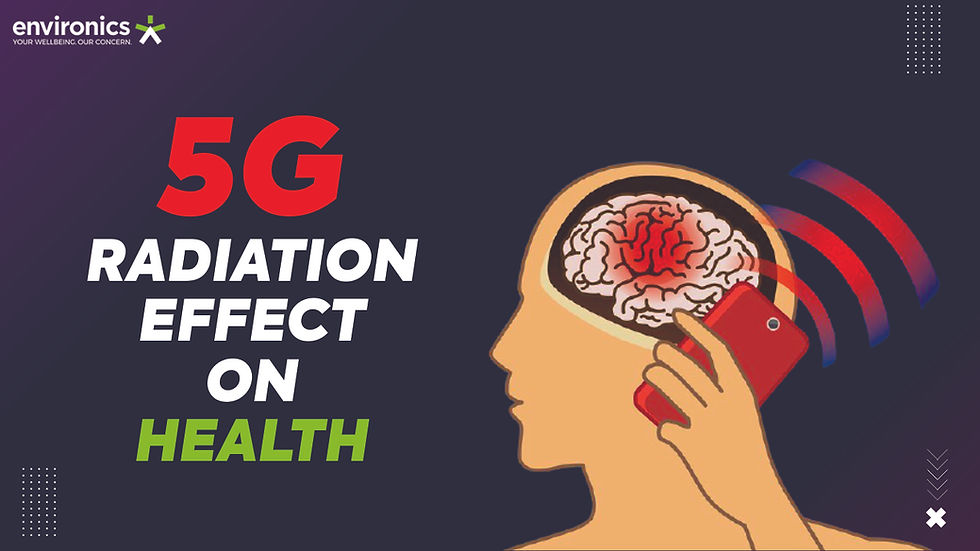The Potential Negative Risks of 5G to Human Health: A Comprehensive Overview
- Phuong Le Ngoc Kim
- Aug 19, 2024
- 5 min read

The rollout of 5G technology, with its promise of faster data speeds, lower latency, and the ability to connect a massive number of devices, marks a significant advancement in telecommunications. However, alongside the excitement surrounding 5G, concerns have emerged about its potential negative impact on human health. These concerns primarily center around the increased exposure to radiofrequency (RF) electromagnetic fields (EMFs) that 5G technology entails. This article explores the potential risks, the current scientific understanding, and the debates surrounding 5G and human health.
1. Increased Exposure to Radiofrequency Radiation
One of the primary concerns regarding 5G technology is the increased exposure to RF radiation. 5G operates at higher frequencies than previous generations, including the use of millimeter waves (MMWs) in addition to the sub-6 GHz spectrum.
Millimeter Waves (MMWs): Unlike the lower frequencies used by 3G and 4G, 5G networks, particularly in urban areas, will employ MMWs, which range from 24 GHz to 100 GHz. These higher frequencies have shorter wavelengths and do not penetrate the skin or objects as deeply as lower frequencies. This means that 5G will require the installation of a dense network of small cells, often located in close proximity to people, potentially increasing overall RF exposure.
Small Cell Deployment: The deployment of small cells, which are low-power base stations, is necessary for 5G to achieve its high speeds and low latency. However, the close proximity of these cells to homes, schools, and workplaces has raised concerns about the chronic exposure to RF radiation at levels higher than those experienced with previous generations of wireless technology.
2. Biological Effects of RF Radiation
The potential biological effects of RF radiation have been a subject of scientific research for decades, even before the advent of 5G. The primary health concerns are related to the possibility that RF radiation could cause or contribute to various health issues.
Thermal Effects: At high levels, RF radiation can cause heating of biological tissue, leading to thermal effects such as burns or tissue damage. However, the power levels used in telecommunications, including 5G, are far below the levels required to cause such effects. The primary concern is whether non-thermal effects—those that occur without a significant increase in temperature—could pose health risks.
Non-Thermal Effects: Some studies have suggested that long-term exposure to low-level RF radiation could lead to non-thermal effects, such as oxidative stress, DNA damage, or disruption of cellular functions. These effects could potentially increase the risk of cancer, neurodegenerative diseases, and other health issues. However, the scientific evidence for these effects remains inconclusive and is a subject of ongoing research and debate.
3. Cancer Risk
One of the most significant concerns about RF radiation is its potential to increase the risk of cancer. The International Agency for Research on Cancer (IARC), a part of the World Health Organization (WHO), classified RF radiation as "possibly carcinogenic to humans" (Group 2B) in 2011, based on limited evidence from human studies and some evidence from animal studies.
Epidemiological Studies: Some epidemiological studies have suggested a possible link between long-term, heavy use of mobile phones and an increased risk of glioma, a type of brain cancer. However, these studies have limitations, and other large-scale studies, such as the INTERPHONE study, have found no consistent evidence of increased cancer risk.
Animal Studies: Experimental studies in animals have produced mixed results. For example, a large-scale study by the National Toxicology Program (NTP) in the United States found "clear evidence" of tumors in the hearts of male rats exposed to high levels of RF radiation. However, the relevance of these findings to humans and the specific context of 5G exposure remains uncertain.
4. Potential Neurological Effects
Another area of concern is the potential impact of RF radiation on the nervous system, particularly the brain. Some studies have suggested that RF radiation could affect brain function, potentially leading to cognitive impairment, sleep disturbances, or other neurological effects.
Cognitive Function and Behavior: There is some evidence to suggest that exposure to RF radiation could affect cognitive functions, such as memory and attention. However, the findings are not consistent, and more research is needed to determine whether these effects are significant and whether they apply to the levels of exposure associated with 5G technology.
Sleep and Circadian Rhythms: Some research has suggested that exposure to RF radiation could disrupt sleep patterns and circadian rhythms. Since 5G will involve more ubiquitous exposure due to the proliferation of small cells, there is concern that it could exacerbate these effects, leading to broader public health issues related to sleep disorders.
5. Electromagnetic Hypersensitivity (EHS)
Electromagnetic hypersensitivity (EHS) is a condition in which individuals report experiencing a variety of symptoms, such as headaches, fatigue, and dizziness, which they attribute to exposure to EMFs, including RF radiation from wireless technologies.
Controversy: EHS is a controversial condition because scientific studies have generally not found a consistent link between EMF exposure and the symptoms reported by individuals with EHS. Some researchers suggest that the symptoms may be due to psychological factors or other environmental conditions rather than the EMFs themselves.
Impact of 5G: With the increase in RF exposure that 5G brings, there is concern that individuals who report EHS may experience a worsening of their symptoms, even if the underlying cause is not directly related to EMF exposure. This has led to calls for further research and better understanding of EHS.
6. Regulatory and Safety Standards
Given the concerns about potential health risks, regulatory bodies around the world have established safety standards for RF exposure. These standards are designed to protect the public by limiting exposure to levels considered safe based on current scientific evidence.
ICNIRP Guidelines: The International Commission on Non-Ionizing Radiation Protection (ICNIRP) sets international guidelines for RF exposure, which are based on avoiding thermal effects and large safety margins. The ICNIRP updated its guidelines in 2020 to account for the frequencies used by 5G, concluding that 5G networks, when operated within these guidelines, pose no health risk.
Precautionary Principle: Despite these guidelines, some public health experts advocate for the application of the precautionary principle, which calls for taking precautionary measures even if the scientific evidence is not conclusive. This could include minimizing unnecessary exposure, particularly for vulnerable populations such as children.
Conclusion
The potential negative risks of 5G to human health remain a topic of active research and debate. While current safety standards are based on extensive scientific research, concerns persist about the long-term effects of increased RF exposure, particularly with the introduction of millimeter waves and the densification of cell networks. As 5G technology continues to expand, it will be crucial to monitor its impact on public health through ongoing research, transparent communication, and appropriate regulatory measures. While the evidence to date suggests that 5G is unlikely to pose significant health risks when deployed within established guidelines, the need for caution and further investigation remains, especially as we enter an era of ubiquitous wireless connectivity.




Comments